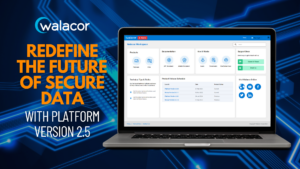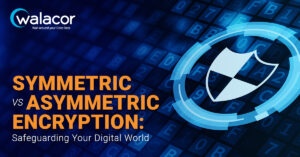In contemporary digital landscapes, safeguarding data has become a pivotal concern for organizations, regardless of size. The need to shield sensitive information from unauthorized access and ensure its integrity, availability, and confidentiality is more important than ever. At the core of this data security endeavor lies the intricate practice of effective key management, where KMIP (Key Management Interoperability Protocol) takes the stage. We recently gave a brief introduction to KMIP, and now it’s time to examine the benefits of KMIP, as well as the challenges and considerations for implementing KMIP protocols.
What is encryption key management?
Encryption key management is the administration of policies and procedures for protecting, storing, organizing, and distributing encryption keys. Encryption keys (also called cryptographic keys) are the strings of bits generated to encode and decode data. Effective encryption key management, usually performed by a Key Management System (KMS), is crucial to the security of sensitive information. In addition to ensuring security, key management also ensures that encryption does not impede the performance or interoperability of secured data.
Benefits of KMIP in Data Security
Centralized Key Management
KMIP allows organizations to consolidate their key management operations into a centralized system. This centralized approach enhances visibility, control, and accountability over cryptographic keys, reducing the risk of unauthorized access or key loss. Centralized key management also simplifies auditing and compliance efforts.
Interoperability and Portability
With KMIP, organizations are not tied to a single vendor for their key management needs. The standardization of the protocol enables seamless interoperability between different key management systems. It ensures the portability of keys and cryptographic objects across various environments, including cloud infrastructures and hybrid deployments.
Enhanced Security
KMIP incorporates robust security measures into its design, ensuring the protection of cryptographic keys and sensitive data. By leveraging hardware-based security modules (HSMs) that adhere to the KMIP standard, organizations can benefit from tamper-resistant storage and processing of keys. This provides an additional layer of protection against key theft, tampering, or misuse.
Simplified Integration
Implementing KMIP allows organizations to seamlessly integrate their key management systems with other cryptographic devices and applications. It simplifies the deployment and management of encryption solutions, enabling organizations to achieve a higher level of security without significant overhead or disruption.
Regulatory Compliance
Compliance with data protection regulations and industry standards is a critical requirement for many organizations. KMIP provides a standardized framework for key management, ensuring that cryptographic operations align with regulatory requirements. By using KMIP-compliant key management solutions, organizations can demonstrate their commitment to data security and meet the compliance obligations set forth by regulations such as GDPR, HIPAA, and PCI DSS.
Scalability and Future-Proofing
As organizations grow and evolve, their data security needs expand as well. KMIP offers scalability and future-proofing capabilities by allowing seamless integration of new cryptographic devices and technologies. Whether organizations adopt cloud computing, implement new encryption algorithms, or incorporate emerging technologies, KMIP ensures that their key management infrastructure can adapt and accommodate these changes without sacrificing security.
Streamlined Operations
By implementing KMIP, organizations can streamline their key management operations and reduce complexity. Standardizing key management processes eliminates the need for custom integrations and reduces the risk of errors and misconfigurations. This leads to operational efficiency, cost savings, and increased productivity, as IT teams can focus on strategic initiatives rather than managing disparate key management systems.
Challenges and Considerations
While KMIP offers significant benefits for data security, there are some challenges and considerations to keep in mind:
Adoption and Vendor Support
Not all key management systems and cryptographic devices are KMIP-compliant. Before implementing KMIP, organizations should ensure that their existing or prospective vendors support the protocol. It’s crucial to evaluate the compatibility of key management solutions and the level of KMIP implementation to ensure seamless integration.
Key Custody and Trust Models
KMIP introduces considerations regarding key custody and trust models. Organizations must carefully define their key ownership, custodianship, and trust relationships within their key management infrastructure. Establishing robust policies and procedures for key custody and access control is essential to maintain data security and prevent unauthorized key usage.
Training and Expertise
Adopting KMIP requires a certain level of understanding and expertise in key management practices and the protocol itself. Organizations should invest in training their IT staff to ensure they possess the necessary skills to effectively implement, operate, and maintain KMIP-compliant key management systems.
Implementation Costs
Integrating KMIP Into an organization’s existing infrastructure may entail initial investments in technology adoption, staff training, and potential adjustments to processes. The cost varies depending on factors such as the deployment scale, the existing environment’s complexity, and the vendor support level. However, it’s essential to view these costs as an investment in long-term security and operational efficiency, as the streamlined key management processes, enhanced security measures, and potential reduction in complexities can outweigh the initial costs.
Implementing robust data security measures is paramount in an era where data breaches and unauthorized access pose significant threats to organizations. KMIP, as a standardized key management protocol, addresses the complexities and challenges of managing cryptographic keys across diverse systems and vendors. By adopting KMIP, organizations can achieve centralized key management, interoperability, enhanced security, and streamlined operations. As data security regulations and technologies continue to evolve, KMIP provides a solid foundation for protecting sensitive information and maintaining compliance. Embracing KMIP empowers organizations to establish a strong security posture and safeguard their critical assets in an increasingly interconnected digital landscape.
Walacor made a strategic decision to support KMIP, allowing customers to centrally manage and safeguard their Walacor seeds using existing systems and processes. The security of all data and networks is quickly becoming a critical requirement for all organizations given the current threat and regulatory environment. With the addition of KMIP support, Walacor helps accelerate our customers’ success on this journey.



